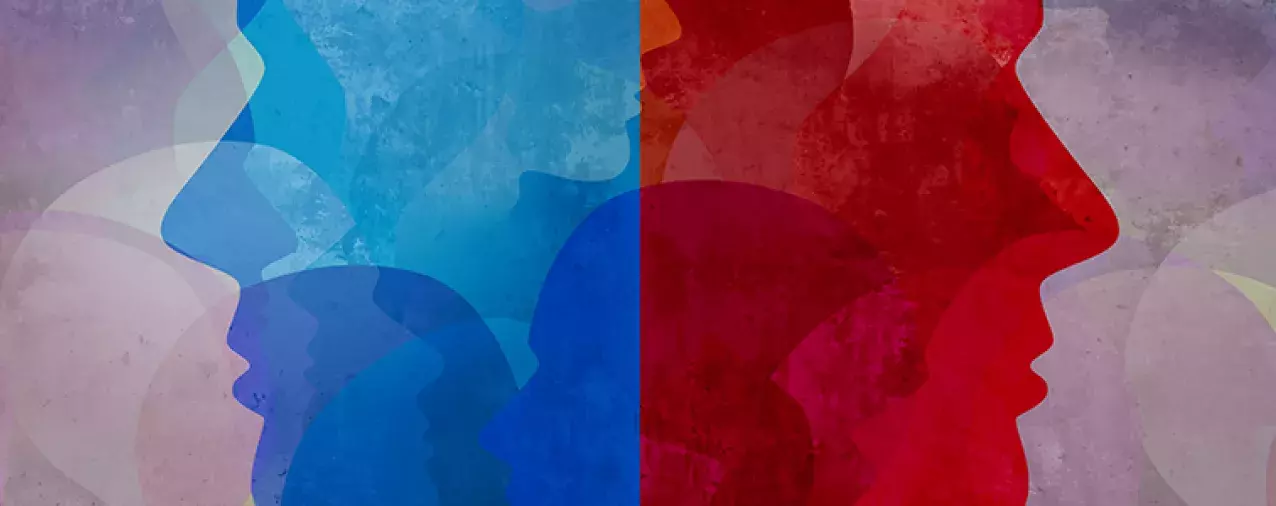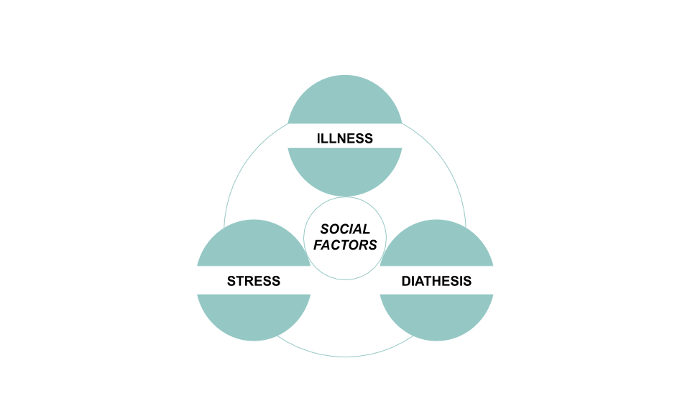Genomics: Insight

Genetics, Schizophrenia, and COVID-19: A Complex Picture
Genetics, Schizophrenia, and COVID-19: A Complex Picture
Schizophrenia is a debilitating mental illness characterized by a break from reality—otherwise known as psychosis. Although schizophrenia has a “relatively low prevalence” in the United States at only about 0.25–0.64%, as of 2018, individuals with schizophrenia were almost 350 times more likely to die by suicide than people in the general population[1]. Schizophrenia is also one of the leading causes of disability worldwide (via a constellation of symptoms including hallucinations, delusions, disorganized thinking and speech, and psychomotor immobility), and is estimated to contribute to an average of 28.5 years of lost life—largely through comorbid medical conditions.1 Research indicates that schizophrenia has a substantial genetic component, with a heritability rate (the proportion of a trait’s variation caused by genes as opposed to the environment) of up to 80%.2 It’s clear that psychosis is a pressing problem, but what does it have to do with COVID-19?
Viral Infection: A Link Between Genes and Schizophrenia
It turns out that viral infection—beyond COVID-19—just might be one link between genes and schizophrenia. The diathesis-stress model, often used to explain the pathogenesis of a particular disorder, outlines the interaction between each of these three pieces; it posits that an underlying diathesis (genes, in this case) may interact with a stressor (COVID-19) to manifest a given illness (schizophrenia).
We first have to understand how genes themselves are intimately tied with schizophrenia. Genome-wide association studies (GWAS) are able to associate phenotypes (e.g., schizophrenia) with single nucleotide polymorphisms (SNPs), or one-letter changes in DNA that occur above a threshold percentage in a given population. In schizophrenia, each SNP confers an additional 1.1–1.2% risk, and a total of over 180 SNPs have been associated with the condition.2, 3 Of these 180 or so SNPs, one in particular affects viral response genes independently of schizophrenia. The C4A gene codes for a certain protein in what’s called the complement system, a major player in innate immunity.4 Interestingly, one study has shown that the gene exhibits a phenomenon called “pleiotropy,” or when a single gene influences the expression of multiple unrelated traits (“varicella zoster virus and schizophrenia,” in this case).5
Another GWAS has indicated the existence of an immunological “component to schizophrenia risk,” pointing to a region called the major histocompatibility complex (MHC).6 This collection of genes codes for cell surface proteins necessary to acquire immunity, and the existence of multiple “significant markers” provides modest evidence supporting the “role for infection” in schizophrenia pathogenesis.6 Meanwhile, other immune-relevant genes such as NRGN and TCF4 may exacerbate problems with “memory and cognition” present in schizophrenia, leading to the condition’s complex neuropsychiatric symptomatology.6
COVID-19 and Schizophrenia: The Intersection
Currently, we don’t have enough research yet to make any definitive statements about a genetic relationship between COVID-19 and schizophrenia, but there are multiple ways—not just biological—that COVID-19 may act as a “stressor” that manifests schizophrenia. Namely, the stress of “contracting the virus” itself may worsen many pre-existing mental health issues.7 People with schizophrenia are also much less likely to live alone, given the nature of their illness. Along with factors such as stigma, discrimination, disorganized thought processes (symptomatology indicative of schizophrenia), comorbid health conditions, and so much more, the risk of SARS-CoV-2 transmission only further increases.8
This is further exacerbated by what are called iatrogenic effects—the contraction or manifestation of a disease from the healthcare system itself. People with schizophrenia that have previously benefited from extensive in-person therapy may now find themselves with the choice of either seeing a therapist in-person and running the risk of COVID-19 infection or needing to sacrifice time and money to adjust to an online setting.
It’s clear that these factors are additive in nature. Intuitively, a person who is living around more people, is in contact with the healthcare system more often, and may have more pre-existing comorbidities is more likely to contract and succumb to COVID-19.8
Regardless of the strength of the biological relationship between schizophrenia and COVID-19, the intersectionality of both illnesses fosters a troubling set of circumstances. For example, current research has outlined an immunological link between COVID-19 and the onset of psychotic symptoms. It’s important to note that SARS-CoV-2 can enter the brain, leading to inflammation, which can in turn lead to changes in “both peripheral and central nervous system (CNS)” function.9 Dubbed “COVID-19 psychosis,” multiple cases of patients with COVID-19 have presented with “auditory hallucinations” and “paranoid and persecutory delusions,” suggesting, but not confirming a causal relationship between the viral response and psychosis.9

Psychosocial Factors
A common misconception about schizophrenia is that it primarily involves symptoms like hallucinations and delusions, or positive (additive) symptoms. While these experiences—especially auditory hallucinations—are hallmark manifestations of schizophrenia, deficits in motivation, expression of emotion, social interest, the ability to feel pleasure, etc. can be just as debilitating, if not more so.
In particular, these negative (reductive) symptoms have been shown to be exacerbated by diminished levels of casual contacts.8 For example, even the once-a-week act of engaging with a cashier when picking up medications is associated with “improved recovery and community integration scores,” which is especially pertinent to people that typically have “smaller and poorer-quality social networks” on average.8 Whether it be the pharmacy or the grocery store, social distancing measures have drastically reduced the number of such (in-person) casual contacts, which may hinder people experiencing negative symptoms. Additionally, now that people with schizophrenia are more likely than ever to be living at home with close relatives, a metric called “expressed emotion” has become increasingly relevant. This term refers to the expression of attitudes (particularly, negative attitudes) by a family member towards a person with a mental illness, which greatly predicts relapse and subsequent hospitalization rates.
The Need for More: The Role of Genome-Wide Association Studies
How does this relate to genetics?
Now more than ever, individuals with mental illnesses have to grapple with stressors, whether they be viral or economic—psychological or societal. Diverse GWAS present an excellent method of ameliorating health disparities, mitigating the impacts of certain stressors. Over time, researchers have been able to discover more and more SNPs contributing to the risk of schizophrenia, which—along with advances in computing for personalized medicine—can map genes to relevant stressors to characteristics of an individual’s experience with schizophrenia and related disorders.
A more comprehensive understanding of the genetic mechanisms behind schizophrenia can transfer into clinical work. For example, if different combinations of SNPs were found to correspond to slight variations in an individual’s schizophrenia, other form of psychosis, etc., clinicians would be able to tailor their work to the specific behavioral patterns exacerbated by such SNPs. In the future, we will hopefully be able to track the complex interplay between genes, schizophrenia, and another COVID-like event, sorting out each and every variation in an individual’s experience. Precision medicine is beginning to arrive in full force, and coupled with increases in the number and diversity of GWAS, people with schizophrenia and related disorders can receive the support that works best for them—possibly even amidst a global pandemic.
Acknowledgements
I would like to thank Dr. Megan Mekinda from the researcHStart program for directing me to this opportunity.
References
- Schizophrenia. (n.d.). The National Institute of Mental Health. Retrieved September 21, 2020, from https://www.nimh.nih.gov/health/statistics/schizophrenia.shtml
- Harrison, P. J. (2015). Recent genetic findings in schizophrenia and their therapeutic relevance. Journal of Psychopharmacology, 29(2), 85–96. https://doi.org/10.1177/0269881114553647
- Huo, Y., Li, S., Liu, J., Li, X., & Luo, X.-J. (2019). Functional genomics reveal gene regulatory mechanisms underlying schizophrenia risk. Nature Communications, 10. https://doi.org/10.1038/s41467-019-08666-4
- C4A gene. (2020, August 17). Genetics Home Reference. Retrieved September 21, 2020, from https://ghr.nlm.nih.gov/gene/C4A#synonyms
- Kachuri, L., Francis, S. S., Morrison, M., Wendt, G. A., Bossé, Y., Cavazos, T. B., Rashkin, S., Ziv, E., & Witte, J. S. (2020). The landscape of host genetic factors involved in immune response to common viral infections. medRxiv [Preprint]. https://doi.org/10.1101/2020.05.01.20088054
- Stefansson, H., Ophoff, R., Steinberg, S., Andreassen, O., Cichon, S., Rujescu, D., Werge, T., Pietiläinen, O., Mors, O., Mortensen, P., Sigurdsson, E., Gustafsson, O., Nyegaard, M., Tuulio-Henriksson, A., Ingason, A., Hansen, T., Suvisaari, J., Lonnqvist, J., Paunio, T., . . . Collier, D. (2009). Common variants conferring risk of schizophrenia. Nature, 440, 744–747. https://doi.org/10.1038/nature08186
- Venkateswaran, K. D., & Hauser, C. T. (2020). Living with PTSD amid a global pandemic. Psychological Trauma: Theory, Research, Practice, and Policy, 12(S1), S71–S72. http://dx.doi.org/10.1037/tra0000857
- Kozloff, N., Mulsant, B. H., Stergiopoulos, V., & Voineskos, A. N. (2020). The COVID-19 global pandemic: Implications for people with schizophrenia and related disorders. Schizophrenia Bulletin, 46(4), 752–757. https://doi.org/10.1093/schbul/sbaa051
- Ferrando, S. J., Klepacz, L., Lynch, S., Tavakkoli, M., Dornbush, R., Baharani, R., Smolin, Y., & Bartell, A. (2020). COVID-19 psychosis: A potential new neuropsychiatric condition triggered by novel coronavirus infection and the inflammatory response? Psychosomatics. https://doi.org/10.1016/j.psym.2020.05.012
About the Author
Keshav Gandhi is a senior at University Laboratory High School in Urbana, Illinois. He is interested in pursuing research in computational biology and hopes to combine this with medicine.